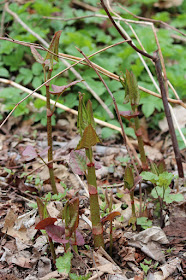October arugula
Late last year, our soil test results from Cornell University came back. The good: no cadmium, super-low arsenic (that is to say well below the minimum levels that send up red flags). The bad: high lead levels. The lead did not surprise me very much - we live in a highly urban environment, but my heart did sink: I grow plants you can eat. And we had been eating bushelsful of arugula up to that point. Nom-nom, nice lead for dinner. Or so I thought, as I freaked out.
The test also revealed a low soil pH of 5.4 - acidic (pH is short for power of hydrogen, if you've ever wondered). 7 is neutral. Above that the soil is alkaline.
As it turned out, pH is one key to lead remediation:
Low pH makes lead available for absorption by plants, although even then, most plants do not absorb much, if any: root crops the most, leaves next, and fruit - seed bearing parts of the plant - minimal, or none;
this 2013 Cornell study was extremely helpful. All my leafy greens? "For lettuce, Pb [lead] levels remained well below the recommended limit even at a soil total Pb concentration of 915mg/kg." That is a lot of lead (we have 560mg/kg. The 'safe' level in NY state is 400mg/kg.)
Still, the lower the pH and the higher the lead levels, the more can be absorbed.
I clung to an early sentence in a less technical
article: "Plants generally do not absorb or accumulate lead in quantities that would be of concern." The main risk of having lead in the soil comes in fact not from inside the plant, but from residue on the
outside of plants that have not been rinsed very well - dust and grit. Small children crawling or playing in garden dust or soil high in lead, and gardeners who do not wash their hands are also at risk of ingesting lead.
Thank goodness I wash my leaves well (in a large basin of water, rinse, and repeat)
November fenugreek
After my initial meltdown (when in doubt, panic -it's a great motivator), I read extensively and relaxed a lot. It took some time for me to come down from the very high branches of my panic tree, but now I'm leaning against its trunk, reading a book and sipping a cocktail. No firepersons required.
Because there is a solution:
raising the pH to make it more neutral (7 is neutral) makes lead unavailable to plants. I learned that garden lime was not what I wanted, because it also contains magnesium, and the soil test said the magnesium levels were fine. Excess magnesium stunts and even kills vegetables. So I chose crushed oyster shells, pure calcium, sent over from California by
Grow Organic, a company that has the best packing practises I have seen (no plastic, no styrofoam - but they ship slowly, be prepared).
December arugula and mustard
In November last year I applied 6lbs of crushed oyster shells (it looks like white dust) to our 100 square foot central plot in the garden, which I will be using for edible crops. I dug it in to about six inches. This application rate I gleaned from Steve Masley's
Grow it Organically, an unusually helpful gardening site.
What I do not know is how many points it will raise my soil's pH, which is key. Grow it Organically gives a points-rating for garden lime, but not shells. If my pH was 5.4 before 6lbs of oyster shells, what is it after? Stay tuned. The quality of the soil affects the change:
the more organic matter in the soil, the smaller the change, because its acts as a buffer. We have lots of organic matter, says the soil test.
Dry egg shells
Over the winter I also collected egg shells,
another excellent source of calcium (after they were dry I stored them in a large mason jar and stomped them down with a wooden spoon handle to make room for more
).
After handcrushing, into the food processor
I pulverized the dry shells in the food processor, and several months' worth yielded 1.5lbs of white powder. It takes several minutes to get the fine powder you want - and open the container outdoors, as there is dust, post whizzing.
Ground eggshells
Recently I applied those to the sunniest end of the vegetable plot, where planting will begin.
Eggshells applied, before digging in
Yes, I will have the soil tested again. And I advise anyone curious about what is actually in their soil to do so, too, because the results can be surprising.
Raised beds are the ideal answer in a heavy metal situation, but that is not an option here, as the cubic feet of potting soil we'd bring in would cost a fortune, which cannot be justified in a rental situation. I could use phytoremediation - using very specific plants like ferns to suck up lead, before disposing (where do you toss them?). I could grow mushrooms - mycoremediation; very effective at removing heavy metals from soil. But I want shorter term results. Hence the sweetening of the soil.
I am immensely relieved to have learned more about soil science, and humbled by how much I still do not know. One could devote a lifetime to it.
Our seeds are arriving, monthly from
Grow Journey and a small batch from
Botanical Interests. Fava beans and spinach have already been planted in the double-calciumed rows. I am waiting on a fresh batch of oyster shells before planting the rest.
The adventure continues. The show ain't over till the fat possum sings.
________________________________________

























































